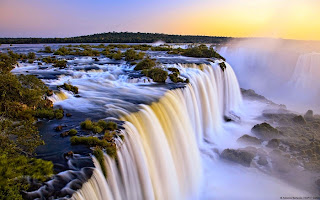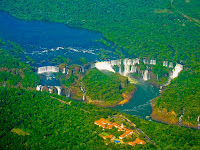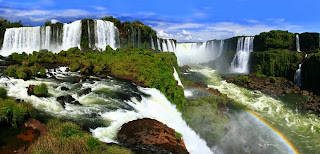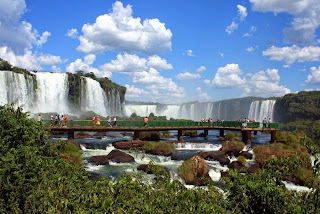Iguazu Falls are waterfalls of the Iguazu River on the border of the Argentina province of Misiones and the Brazilian state of Paraná. The falls divide the river into the upper and lower Iguazu. The Iguazu River rises near the city of Curitiba. For most of its course, the river flows through Brazil, however, most of the falls are on the Argentine side. Below its confluence with the San Antonio River, the Iguazu River forms the boundary between Argentina and Brazil.
The Iguazu Falls are arranged in a way that resembles a reversed letter "J". The border between Brazil and Argentina runs through the Devil's Throat. On the right bank is the Brazilian territory, which has just over 20% of the jumps of these falls, and the left side jumps are Argentine, which make up almost 80% of the falls.
Iguazu Falls is located where the Iguazu River tumbles over the edge of the Paraná Plateau, 23 kilometres (14 mi) upriver from the Iguazu's confluence with the Paraná River. Numerous islands along the 2.7-kilometre-long (1.7 mi) edge divide the falls into many separate waterfalls and cataracts, varying between 60 to 82 metres (197 to 269 ft) high. The number of these smaller waterfalls fluctuates from 150 to 300, depending on the water level. Approximately half of the river's flow falls into a long and narrow chasm called the Devil's Throat (Garganta del Diablo in Spanish or Garganta do Diabo in Portuguese). The Devil's Throat is U-shaped, 82 metres high, 150 m wide, and 700 m long (269×492×2,297 ft). Placenames have been given also to many other smaller falls, such as San Martín Falls, Bossetti Falls, and many others.
On the Brazilian side, there is a walkway along the canyon with an extension to the lower base of Devil's Throat. Helicopter rides offering aerial views of the falls have been available from Brazil, however, Argentina has prohibited such helicopter tours because of the adverse environmental impact on the flora and fauna of the falls. From Foz do Iguaçu airport, the park may be reached by taking a taxi or bus to the entrance of the park. There is an entrance fee to the park on both sides. Once inside, free and frequent buses are provided to various points within the park. The town of Foz do Iguaçu is approximately 20 kilometres (12 mi) away, and the airport is between the park and the town.
The Argentine access, across the forest, is by a Rainforest Ecological Train very similar to the one in Disney's Animal Kingdom. The train brings visitors to the entrance of Devil's Throat, as well as the upper and lower trails. The Paseo Garganta del Diablo is a 1-kilometre-long (0.6 mi) trail that brings visitors directly over the falls of Devil's Throat, the highest and deepest of the falls. Other walkways allow access to the elongated stretch of falls across the forest on the Argentine side and to the boats that connect to San Martin Island. Also on the Argentine side, there have been inflatable boat services that take visitors right under the falls.




